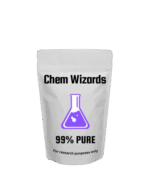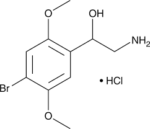

Buy βOH-2C-B hydrochloride
$30.00 – $240.00Price range: $30.00 through $240.00
βOH-2C-B hydrochloride is a beta-hydroxy psychedelics phenethylamine research chemical, structurally related to 2C-B, used for serotonin receptor pharmacology and neuropharmacological studies.
Important Notice:
European customers should complete their purchases in USD (not CAD). After placing your order and before manual payment, the currency will be converted to Euros.
Canadian customers should use CAD, and American customers should use USD.
βOH-2C-B Hydrochloride Product Description
Introduction
βOH-2C-B hydrochloride, also known as beta-hydroxy-2C-B hydrochloride, is a synthetic psychedelic compound belonging to the substituted phenethylamine family. It is the beta-hydroxy structural analogue of the well-known 2C-B, a classical psychedelic phenethylamine. βOH-2C-B HCl presents as a crystalline solid and is primarily used in research related to serotonin receptor pharmacology and novel psychoactive substances. It is a relatively obscure compound that has appeared occasionally as a research chemical in recent years.
Chemical Properties and Specifications
Structural and Molecular Characteristics
-
Chemical Formula: C10H14BrNO3 · HCl
-
Molecular Weight: 312.59 g/mol
-
CAS Number: 807631-10-3
-
IUPAC Name: 2-Amino-1-(4-bromo-2,5-dimethoxyphenyl)ethan-1-ol hydrochloride
-
Synonyms: βOH-2C-B hydrochloride, beta-hydroxy 2C-B hydrochloride, BOH-2C-B hydrochloride
Physical Properties and Purity Standards
-
Appearance: Crystalline solid, typically white or slightly off-white powder
-
Purity: ≥98% research grade purity
-
Solubility: Soluble in water and organic solvents; enhanced solubility due to hydrochloride salt form
-
Storage Recommendations: Store in a cool, dry, and dark place, preferably at temperatures below 20°C; protect from moisture and direct sunlight to maintain stability
Pharmacological Profile and Mechanism of Action
Proposed Mechanism of Action
βOH-2C-B acts primarily as a psychedelic phenethylamine by interacting with serotonin (5-HT2A) receptors, which modulates perception, cognition, and mood. The beta-hydroxy group on the ethylamine side chain alters its receptor binding affinity and pharmacodynamics compared to 2C-B. While comprehensive pharmacological profiling is limited, βOH-2C-B is believed to be a partial or full agonist at 5-HT2A receptors, classifying it within classical serotonergic psychedelics.
Research Applications
This compound is investigated for its interaction with serotonin receptors to understand the effects of beta-oxygenation on psychedelic activity. βOH-2C-B’s study contributes to research on novel psychoactive substances (NPS) and the development of receptor-specific ligands. It is also employed in toxicological and forensic research due to its appearance in the grey market.
Comparative Analysis with Related Compounds
Comparison to 2C-B
βOH-2C-B hydrochloride shares a similar chemical framework to 2C-B but differs by having a hydroxy group at the beta position of the side chain. This modification impacts its physicochemical and pharmacological properties, possibly altering potency, duration, and receptor interaction. Unlike 2C-B, which is widely studied, βOH-2C-B remains less characterized but is noted for potential differences in toxicity and subjective effects.
| Feature | βOH-2C-B Hydrochloride | 2C-B |
|---|---|---|
| Chemical Formula | C10H14BrNO3 · HCl | C10H14BrNO2 |
| Molecular Weight | 312.59 g/mol | 260.14 g/mol |
| Functional Group | Beta-hydroxy substitution | No hydroxy group |
| Receptor Target | 5-HT2A receptor (presumed) | 5-HT2A receptor (confirmed) |
| Appearance | Crystalline solid | Crystalline powder |
Advantages for Research
βOH-2C-B offers insight into how beta-position oxygenation influences the pharmacology of 2C family psychedelics. It serves as a reference compound in structure-activity relationship studies and may help elucidate the role of hydroxyl substitutions in receptor binding and toxicity profiles.
Safety and Handling Guidelines
Laboratory Safety
Due to limited toxicity data, handle βOH-2C-B hydrochloride with caution, using standard laboratory protective equipment: gloves, lab coat, and eye protection. Work in a well-ventilated area or fume hood to avoid inhalation or contact exposure.
Disposal and Environmental Considerations
Dispose of βOH-2C-B hydrochloride material following institutional hazardous waste protocols. Avoid environmental contamination by limiting release to sewage or soil.
Regulatory Status
βOH-2C-B hydrochloride is a research chemical with no approved medical use. It may be subject to regulation or control in some jurisdictions due to its structural similarity to scheduled psychedelics like 2C-B. Always verify local regulatory compliance before handling or procurement.
Frequently Asked Questions (FAQs)
-
What is βOH-2C-B hydrochloride used for?
It is used primarily for research into psychedelic phenethylamines and serotonin receptor pharmacology. -
How does βOH-2C-B differ chemically from 2C-B?
βOH-2C-B features a beta-hydroxy group on its side chain, which 2C-B lacks, modifying its properties and receptor interactions. -
Is βOH-2C-B safe for human consumption?
No, it is intended solely for laboratory research and is not approved for human use. -
What are the storage requirements for βOH-2C-B hydrochloride?
Store in a cool, dry place away from light, ideally below 20°C, to maintain stability. -
What is the purity level of βOH-2C-B hydrochloride for research?
Research-grade βOH-2C-B hydrochloride is typically supplied with purity ≥98%.
Conclusion
βOH-2C-B hydrochloride is a beta-hydroxy derivative of the psychedelic 2C-B, exhibiting unique chemical and pharmacological characteristics. Its crystalline hydrochloride salt form enhances solubility and stability for research use. While relatively underexplored, it plays a critical role in expanding understanding of substituted phenethylamine psychedelics, particularly regarding beta-oxygenation effects. Proper handling, storage, and regulatory compliance are essential given its novel psychoactive substance status.
| Quantity |
0.25 grams ,0.50 grams ,1 gram ,5 grams |
|---|
Related products

Buy 2F-DCK 100MG Pellets
$3,495.00 – $118,995.00Price range: $3,495.00 through $118,995.00
Buy 2F-DCK 50 MG Pellets
$2,195.00 – $31,495.00Price range: $2,195.00 through $31,495.00
Buy Chem-mist 2F-DCK spray 10%
$3,596.00 – $30,596.00Price range: $3,596.00 through $30,596.00
Buy Chem-mist 2F-DCK spray 30%
$6,746.00 – $62,096.00Price range: $6,746.00 through $62,096.00
Buy DCK (Deschloroketamine)
$2,295.00 – $69,995.00Price range: $2,295.00 through $69,995.00
Buy Flubromazepam 10 MG Pellets
$1,395.00 – $21,995.00Price range: $1,395.00 through $21,995.00













Reviews
There are no reviews yet.